Mac Os X Server 10.6 64 Bit Vmx Download
AppleInsider is supported past its audience and may earn committee as an Amazon Associate and affiliate partner on qualifying purchases. These affiliate partnerships do not influence our editorial content.
Adjacent yr's x.6 reference release of Mac Os X promises to deliver technology updates throughout the system without focusing on the customer-facing marketing features that typically sell a new operating organization. Hither's a look at what those backside-the-scenes enhancements will mean to you, starting with new 64-bit support.
Follow up segments have a more detailed look at the bug related to the amount of RAM that can be installed and really used by the organization, how much memory a specific app tin reserve for itself, how the Bone gets faster with 64-bit addressing despite the additional overhead involved, how the market place for 64-bit apps is unfolding, and how Apple is pioneering 64-bits on the desktop.
three: Twice the RAM, half the price, 64-bits
four: The Future of 64-bit Apps
The march toward 64-fleck
Through the 1980s, personal computers apace moved from viii-bit to 16-bit to 32-bit architectures, with each accelerate enabling the operating system and its applications to address more than retention and more efficiently handle the memory bachelor to them. The eight-scrap computers of the early 80s could only directly address 64K, the upper limit of their 16-flake memory addressing; early Apple II systems switched between two banks providing 128K. DOS 8086 PCs with 20-flake addressing could handle a whopping 1MB of RAM, but overhead effectively express them to using 640K of it. These early on machines also highlight the fact that a CPU'due south architecture, memory accost passenger vehicle, and its data registers (used to load and shop instructions) may all accept different bit widths.
Similarly, the 1984 Macintosh jumped to using a 32-bit 68000 processor with 24-scrap addressing, allowing the theoretical use of "only" 16MB, although at the time that was far more RAM than anyone could afford. That seemingly high limit eventually became a problem for memory hungry applications, particularly with the increased demands required by graphical computing and multitasking.
Past the finish of the 80s, Apple had delivered full 32-bit hardware with the Mac II'south 68020 processor and the "32-fleck make clean" Mac Organization seven software, which together enabled applications and the system to theoretically utilize as much every bit 4GB of directly addressable memory. Past 1995, Microsoft was aircraft its own 32-fleck Windows API with WinNT and Win95 to take reward of Intel'south 32-bit 80386 and 486 CPUs.
More than bits hither and at that place
A decade after, the 4GB limit of 32-chip memory addressing would begin to pinch fifty-fifty home computers. To suit that inevitability, Apple began its migration to PowerPC in 1994 to make progress toward 64-chip calculating and break from the limitations of the Motorola 680x0 processors information technology had been using. PowerPC offered a scaled downwards version of IBM's modern 64-scrap Power architecture, with 32 individual 32-bit general purpose registers; Intel's 32-bit x86 was a scaled up version of a xvi-bit processor, and but offered eight, 32-fleck GPRs. The lack of registers on x86 served as a significant constraint on potential performance and complicated development.
In order to assault the RAM limitation problem in advance of moving to 64-bit CPUs, Intel added support for "Physical Address Extension" or PAE to its 32-bit x86 chips, which provided a form of 36-flake memory addressing, raising the RAM limit from 4GB to 64GB. Using PAE, each application can nonetheless but address 4GB, but an operating system can map each app'southward express allocation to the physical RAM installed in the reckoner.
Being able to use more than than 4GB of RAM on a 32-bit PC requires back up for PAE in the OS kernel. Microsoft has only supported this extra RAM in its Enterprise, Datacenter, and 64-scrap versions of Windows; the standard 32-bit versions of Windows XP, Vista, and Windows Server are all all the same constrained to using 4GB of physical RAM, and they tin can't provide full access to more than well-nigh 3.5GB of it, making the limit an increasingly serious problem for desktop Windows PC users.
In the tardily 90s, Windows NT was ported to 64-bit architectures such equally Digital's Alpha, MIPS, PowerPC, and Intel'south ill-blighted Itanium, only this as well just benefitted high-end workstation users. Apple'due south own mid-90s PowerPC transition prepared the Mac platform for an easier transition to 64-bit computing, only it wasn't until 2003 that the PowerMac G5 introduced existent 64-flake hardware. The G5 processor delivered 32 individual 64-bit GPRs and a 42-flake MMU (memory management unit) for straight addressing 4TB of RAM, although the PowerMac G5 hardware was limited to 8GB.
The mainstream PC remained stuck at 32-chip conventions until AMD released its 2003 Opteron CPU using an "AMD64" compages that turned out to be a more applied alternative to upgrading into the world of 64-bits than Intel'due south entirely new Itanium IA-64 design. The new 64-bit PC, as well called x86-64 and x64, largely caught up to PowerPC by suppling 16, 64-bit GPRs, and potentially a 64-bit memory passenger vehicle to address 16EB (16 million TB) of RAM. AMD'southward x64 processors can theoretically address 48-$.25, or 256TB, in hardware. In practice, no PC operating organisation currently supports more than 44-bits, or 16TB of virtual retention, and of course considerably less physical RAM.
On folio 2 of 3: The claiming of moving to 64-bits; Windows and 64-$.25; and One footstep back ii steps frontward.
There's currently no immediate need for such vast amounts of RAM among domicile users, but consumers are running into the 4GB barrier of 32-chip PCs, while facing boosted issues that prevent mass migration to x64. The main problem is that the potential of the hardware has to be exposed by operating system software. There are two problems: the first is simply addressing more 4GB of total RAM for the entire organisation, and the second is allowing RAM-hungry applications to individually access large amounts of RAM.
Fifty-fifty with the 64-bit Power Mac G5 hardware, in that location were nonetheless software limitations in 2003'south Mac Os X Panther; the 32-bit OS allowed the arrangement to back up more than 4GB of memory simply still corralled each application into its own 32-bit, 4GB space. With 2005's Mac OS X Tiger, Apple tree enabled desktop apps to spin off processes and servers that could handle enormous memory addressing of their ain: up to a theoretical xvi EB of 64-fleck virtual memory and a conceptual 42-$.25 or 4TB of physical RAM, although aircraft Macs all the same could simply support 8GB of RAM.
To enable this, Tiger supplied a 64-bit version of libsystem, the organization library treatment most of its Unix APIs. This followed the LP64 model to permit broad compatibility with 64-bit versions of Linux and commercial Unix. It also delivered a 64-bit PowerPC ABI (application binary interface) for accommodating native 64-flake apps on the G5. Tiger nonetheless used a 32-bit kernel (although it was not express to 32-bit memory addressing, so it could actually make employ of the 8GB of RAM installed in G5s), and information technology was besides still missing a 64-bit version of the Cocoa or Carbon APIs, which meant apps with a user interface had to be 32-fleck.
Yet, a 32-bit graphical app on Tiger could spin off a faceless 64-bit groundwork process to perform number crunching on a vast data gear up requiring a 64-chip retention infinite, which could so communicate the results dorsum to the 32-bit foreground app running in parallel. Apple also delivered a machinery for deploying applications using a bundle of both 64-scrap and 32-fleck code, allowing the system to automatically run the appropriate version for the Mac hardware in use. Tiger itself besides supplied both 32- and 64-fleck underpinnings, allowing one Bone to run on any Mac. This has made information technology easier for Apple tree to rapidly migrate Mac users toward 64-bit hardware.
Windows and 64-Bits
In contrast, a separate 64-bit version of Windows is required to run 64-scrap Windows apps on 64-bit x86 PCs, and whatsoever 32-bit apps take to run in a special compatibility environment (below). There is no slick mechanism for deploying bundles of mixed lawmaking that "just work" on both architectures, and 64-scrap Windows itself lacks the ability to run on either type of PC. This has had a chilling upshot on the popularity of and the momentum backside 64-chip Windows that parallels the problems with Vista.
This is particularly unfortunate because the advances delivered in the x64 PC are more badly needed by PC users to proceeds the same benefits that Mac users and developers gained from the move to PowerPC over a decade earlier. The 32-flake PC is particularly hampered by a lack of GPRs and the 4GB RAM limit imposed by the desktop versions of 32-fleck Windows. In addition, 32-chip Windows itself eats into that 4GB to but exit 3.5GB of RAM or less for apps and the organization to use, and typically limits individual apps to a tiny 2GB address space.
Software compatibility, a lack of drivers, and other issues have also complicated the move to 64-fleck Windows, leaving mainstream Windows users stuck at 32-$.25. Windows vii was initially supposed to movement users to 64-bits in peradventure 2010, simply reports point that it too will be delivered in separate 32- and 64-bit versions.
One step dorsum two steps forrard
When Apple began migrating to Intel in 2006 information technology actually had to take a step backward, as it only initially supported 32-bit Intel systems with the Core Solo and Core Duo CPUs. Apple had to cope with the same 32-flake PC limitations Microsoft had been dealing with. in the Intel transition, Mac developers lost the features supplied past PowerPC, including its liberal supply of registers. All the same, Intel'south new 32-flake Core Duo was fast enough in other areas to skirt around the problem, specially in laptops where the aging G4 was holding Macs dorsum.
By the end of the yr Apple had widened support to include the 64-chip x64 PC compages in the new Mac Pro and Xserve, and subsequent desktop Macs using the Core ii Duo besides delivered 64-scrap hardware back up. With updates to Tiger, Apple tree delivered the same level of 64-scrap support for x64 Intel processors equally information technology had for the PowerPC G5.
Within the class of i year, Apple had not only adroitly moved its entire Mac production line to Intel but also paved the style forward to speedily push its users to 64-$.25, narrowly escaping the disaster of existence left the last member of the desktop PowerPC party. In its spare time, the company also threw the iPhone together while also working to develop its side by side leap in 64-scrap operating system software.
On page 3 of 3: The 64-bit GUI in Leopard and The 64-bit Kernel in Snow Leopard.
In Leopard, Apple expanded 64-bit support further, calculation 64-chip support in the higher levels of Carbon and Cocoa. Apple tree delivered its own Xcode app in Leopard with support for both PowerPC and Intel in both 32-fleck and 64-chip versions, all within the same awarding bundle. The entire Os is now a Universal Binary as well; it automatically runs on whatever hardware it is installed on. Incidentally, one of the biggest issues in getting Mac Bone X to run on generic PC hardware is the need to plow off PAE in the kernel for older CPUs that don't support it.
While all of Cocoa is now 64-chip, Apple chose not to deliver full 64-bit support in Carbon's user interface APIs (including legacy parts of QuickTime), forcing developers to migrate their apps to use the mod equivalents in Cocoa in order to deliver full 64-flake applications with a user interface. Carbon can still be used to build faceless 64-bit background apps that collaborate with a 64-bit Cocoa front, similar to how Tiger supported 64-flake groundwork apps. Earlier, Apple had added transitional support for mixing Cocoa into Carbon apps to make this move easier.
Apple tree's decision to withhold the development of 64-bit Carbon caused Adobe to announce this leap that its upcoming Creative Suite 4 would only be delivered as a 64-fleck app on Windows. Because CS4's legacy code is based on Carbon, Adobe said it wouldn't be able to deliver a 64-bit version of its Mac apps until at least CS5, because it will require porting the interface code of Photoshop and its companion apps to Cocoa in the model of Photoshop Lightroom. Nigh desktop apps don't necessarily demand 64-bit back up, but Photoshop'due south use of extremely big image files makes it a practiced candidate for porting.
Currently, Mac Os Ten Leopard hosts both 32-scrap and 64-fleck apps on top of a 32-bit kernel (beneath). Using PAE, the 32-bit kernel can address 32GB of RAM in the Mac Pro and Xserve; Apple tree'south consumer machines only support 4GB RAM, simply dissimilar 32-bit operating systems they can utilise the entire 4GB (with appropriate hardware support). Leopard'due south 32-bit kernel enabled Apple to ship 64-bit development tools to give coders the ability to build applications that tin can work with huge data sets in a 64-bit virtual retention space (and port over existing 64-fleck code), without also requiring an immediate upgrade to all of Mac Bone 10's drivers and other kernel-level extensions. That transition will happen with Snowfall Leopard.
How big of a deal is the move to 64-bit apps? As Apple tree'south developer documentation points out, "To put the difference betwixt 32-scrap and 64-bit computing into perspective, imagine that you are working with a dataset in which the road area of the Golden Gate bridge can be represented in a 32-bit accost space. With 64 bits of address space, you have the ability to model the entire surface of the Earth at the same resolution."
The 64-bit Kernel in Snow Leopard
Apple tree is expanding its 64-bit support in Snow Leopard downward into the kernel. This will enable Mac systems to suit more than the 32GB of RAM currently bachelor via 32-bit PAE. With kernel support for full 64-bit retentiveness addressing, Apple tin can add every bit much RAM equally users tin afford. Of class, if you lot're buying RAM from Apple, upgrading a Mac Pro to 32GB of RAM currently costs $ix,100, and so it might exist some time before home users decide they need more than that much RAM.
While Leopard's 32-chip kernel can run both 32- and 64-chip apps, a 64-bit app tin can not load 32-bit plugins or shared libraries, and vice versa. The 64-bit kernel similarly requires 64-scrap kernel extensions and drivers, as it can't mix 32- and 64-bit code either. The move to a 64-flake kernel volition therefore crave an across-the-board upgrade for all kernel drivers in Snowfall Leopard.
Snow Leopard will also require developers who write any plugins for Mac Os X apps to recompile their code to 64-bit. This includes everything from Organization Preferences panes to web plugins. The reason for the massive upgrade will be that Apple will also evangelize the entire organization compiled equally both 32- and 64-scrap, from the Finder to iTunes to Safari. On 32-scrap Macs, Snow Leopard will run normally, but on x64 Macs, everything will get a meaning boost as every app on the organization volition benefit from the advantages of x64, particularly the extra registers supplied by x64 and missing from the 32-bit PC.
That advantage volition outweigh the boosted overhead caused past moving to 64-bits and the resulting utilise of larger data items. In contrast, at that place would be no existent reward in recompiling Snow Leopard and its apps for 64-flake PowerPC G5s, as the G5 is not currently constrained past the annals trouble of 32-bit x86; the 64-scrap G5 has the same number of registers as the G4, because the G4 already had plenty. The G5 actually runs 64-bit apps slightly slower because of the increased overhead imposed by 64-bit addressing. For that reason, Snow Leopard will apparently exist Intel-only.
More information on Snow Leopard appears on AppleInsider'southward Mac OS Ten 10.half-dozen page.
Mac Os X Server 10.6 64 Bit Vmx Download
Posted by: sturgeonsmir1988.blogspot.com
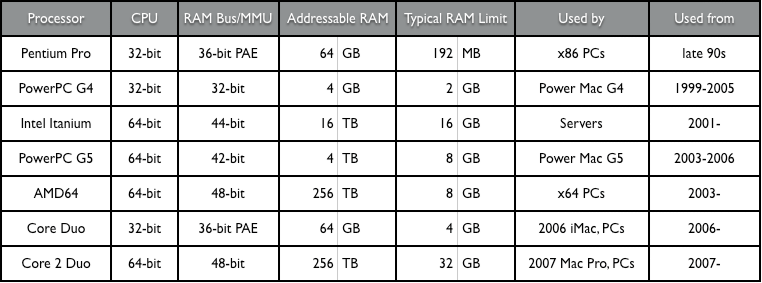
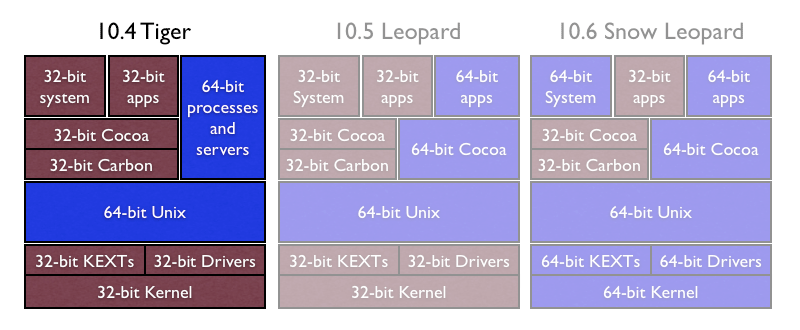
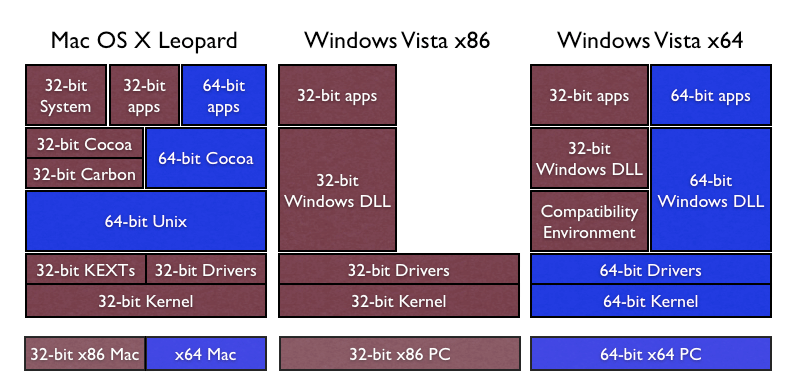
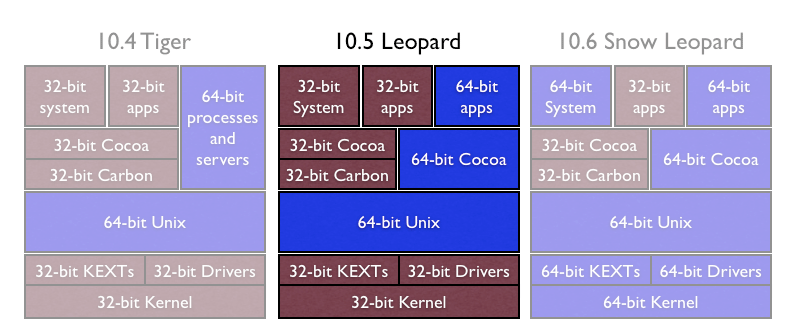
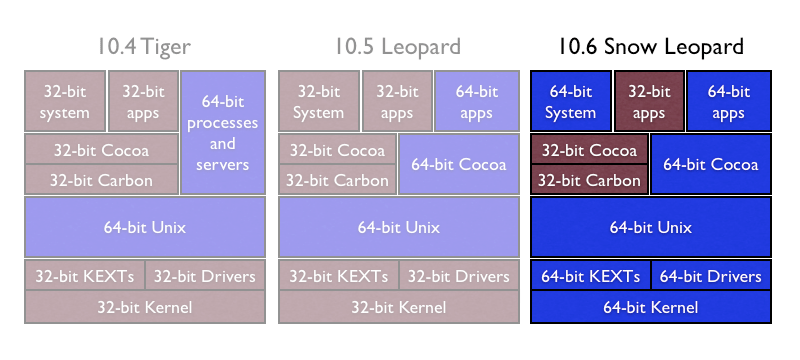

0 Komentar
Post a Comment